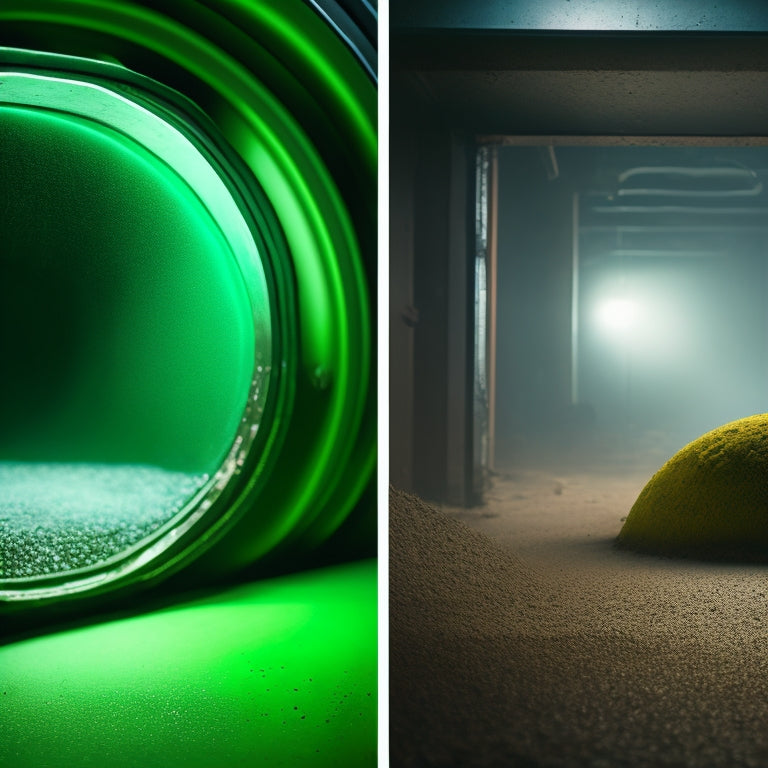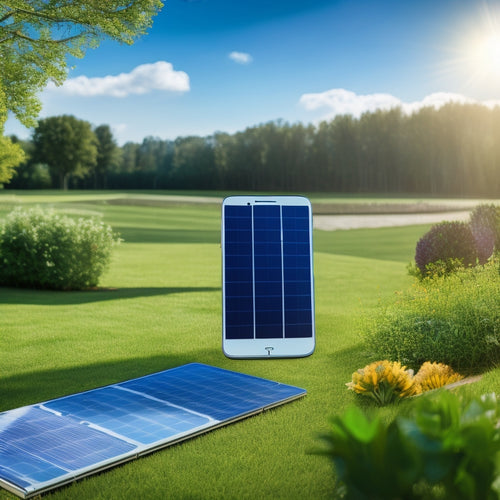
Green Duct Cleaning: Breathing New Life Into HVAC
Share
By embracing green duct cleaning methods, you're not only revitalizing your HVAC system but also contributing to a healthier environment. Eco-friendly techniques involve using biodegradable cleaners, natural sanitizing methods, and reusable tools to minimize waste and carbon footprint. Regular energy audits and sustainable system design choices also play an essential role in reducing energy consumption and optimizing airflow. As you investigate these environmentally responsible practices, you'll find a multitude of benefits, from improved indoor air quality to reducing your carbon footprint, and revealing the full potential of your HVAC system awaits.
Key Takeaways
- Green duct cleaning methods focus on biodegradable cleaners, natural products, and reusable tools to minimize environmental contamination and waste.
- Improving indoor air quality involves physically removing dirt, dust, and debris, and addressing pollen, mold, and insect/rodent droppings.
- Duct sanitizing techniques use ozone, steam, UV, and antimicrobial solutions to reduce allergens and pollutants, and maintain superior air quality.
- Sustainable HVAC system design incorporates renewable energy sources, energy-efficient equipment, and optimized system sizing to reduce carbon footprint.
- Clean air duct systems optimize HVAC performance, reduce energy consumption, and enhance comfort, contributing to a reduced carbon footprint and healthier living environment.
Eco-Friendly Duct Cleaning Methods
When it comes to HVAC duct cleaning, many homeowners prioritize eco-friendly methods to minimize their environmental footprint. You're likely no exception, seeking to breathe easy while keeping your conscience clear.
Eco-friendly duct cleaning methods are designed to improve air quality without harming the planet. One key aspect is the use of biodegradable cleaners, which break down naturally and don't contaminate soil or water. These cleaners effectively remove dirt, dust, and debris from your ducts, ensuring the air circulating in your home is fresh and clean.
By incorporating sustainable practices, such as reducing fossil fuel dependence, into your cleaning routine, you can further minimize your environmental impact.
Sustainable HVAC System Design
A well-designed HVAC system is crucial for maintaining a comfortable and sustainable indoor environment. You want a system that not only provides a healthy indoor air quality but also reduces your carbon footprint.
To achieve this, consider the following design elements:
-
Sustainable materials: Choose materials with low embodied energy, recycled content, and recyclable properties.
-
Renewable energy sources: Incorporate solar, geothermal, or wind power to reduce dependence on fossil fuels, such as using green hydrogen fuel cells that offer durability and lower maintenance costs. This can greatly reduce greenhouse gas emissions, improving air quality and supporting corporate sustainability goals.
-
Energy-efficient equipment: Select equipment with high energy efficiency ratings to minimize energy consumption.
- Optimized system sizing: Ascertain the system is properly sized to meet your specific heating and cooling needs, reducing energy waste.
Green Duct Cleaning Solutions
You'll want to investigate eco-friendly cleaning methods that minimize environmental impact while maintaining effectiveness.
These green duct cleaning solutions often involve duct sanitizing techniques that use natural or biodegradable products to eliminate contaminants.
By adopting natural debris removal methods, you can guarantee a cleaner, healthier indoor air environment while reducing your carbon footprint.
Furthermore, incorporating renewable energy sources, such as solar-powered fast charging, can further reduce the carbon footprint of your HVAC system.
Additionally, using energy storage systems can maintain a stable power supply during peak demand, optimizing system performance while minimizing energy waste.
Eco-Friendly Cleaning Methods
Switching to eco-friendly cleaning methods is a significant step towards reducing the environmental impact of HVAC duct cleaning.
You'll be pleased to know that eco-friendly methods don't compromise on effectiveness. In fact, they promote better air quality and a healthier indoor environment.
When it comes to eco-friendly cleaning methods, you can opt for:
-
Biodegradable cleaners that break down naturally, reducing harm to the environment. By adopting these sustainable practices, you can reduce carbon footprint and contribute to a greener future. Additionally, conducting regular energy audits can help identify areas for improvement in your HVAC system.
-
Using reusable cleaning tools to minimize waste and reduce the carbon footprint.
-
Low-moisture cleaning techniques that conserve water and energy.
- Natural ventilation methods that utilize the power of fresh air to improve air quality.
Duct Sanitizing Techniques
In conjunction with eco-friendly cleaning methods, incorporating duct sanitizing techniques into your HVAC duct cleaning routine is vital for maintaining a healthy indoor environment.
By adopting sustainable practices, similar to those found in solar-powered solutions, you can reduce your carbon footprint and promote a cleaner environment.
You'll want to employ ozone treatment, steam cleaning, and UV sanitization to eliminate microbial growth and reduce allergens. Antimicrobial solutions can also be applied to prevent future growth.
Regular air filter maintenance is essential to guarantee superior air quality.
During duct inspection, pay attention to ventilation assessment and air quality monitoring to identify areas that require sanitizing.
Natural Debris Removal
Every square inch of your ductwork can harbor debris and dirt, making natural debris removal an essential step in maintaining a healthy indoor environment.
This process involves physically removing dirt, dust, and other natural pollutants that can contaminate your air quality. By doing so, you can breathe easier and enjoy a cleaner living space.
Here are some common sources of natural debris that can affect your air quality:
-
Dust and dirt: These tiny particles can circulate in the air, aggravating respiratory issues and causing discomfort.
-
Pollen and mold spores: These allergens can trigger allergic reactions and exacerbate respiratory conditions.
-
Insect and rodent droppings: These can introduce harmful bacteria and viruses into your air supply.
- Decaying organic matter: This can release harmful gases and compounds that can negatively impact indoor air quality.
Energy Efficiency Through Clean Air
A clean air duct system is the unsung hero of energy efficiency, quietly saving you money on your utility bills while keeping your indoor air quality exceptional.
When your ducts are clean, your HVAC system operates at peak performance, maximizing airflow optimization and energy recovery. This means your system doesn't have to work harder to circulate air, reducing energy consumption and your carbon footprint.
As a result, you'll enjoy lower energy bills and a more comfortable living space.
Non-Toxic Duct Sanitizing Techniques
You'll often find that traditional duct sanitizing methods involve harsh chemicals that can compromise your indoor air quality.
These chemicals can aggravate respiratory issues and create unpleasant odors.
In contrast, green duct cleaning focuses on non-toxic duct sanitizing techniques that prioritize your health and the environment.
Some effective natural sanitizers include:
- Hydrogen peroxide-based solutions, which are biodegradable and gentle on duct materials.
- Plant-based sanitizers, such as tea tree oil, which have antimicrobial properties.
- Enzyme-based cleaners, which break down organic matter and eliminate odors.
- UV light technology, which uses light to sanitize ducts without chemicals.
These natural sanitizers and biodegradable solutions guarantee your ducts are clean and sanitized without exposing you to harmful chemicals.
Improving Indoor Air Quality Naturally
By adopting non-toxic duct sanitizing techniques, you're taking a significant step towards improving your indoor air quality. This allows you to breathe easier, knowing you're reducing pollutant sources that can aggravate allergies and compromise health.
Natural solutions like indoor plants and air purifiers can further enhance air quality, while proper ventilation systems and moisture control guarantee fresh air circulates throughout your space.
By combining these strategies, you'll enjoy significant health benefits and a more comfortable living environment.
Environmentally Responsible Coil Cleaning
During routine HVAC maintenance, it's essential to prioritize environmentally responsible coil cleaning to guarantee peak system performance and minimize ecological footprint.
By adopting eco-conscious practices in coil maintenance, you'll not only reduce your system's energy consumption but also extend its lifespan.
Here's how to do it:
-
Use eco-friendly cleaning solutions that are biodegradable and non-toxic to minimize harm to the environment.
-
Opt for gentle cleaning methods that avoid damaging the coils and surrounding components.
-
Schedule regular coil maintenance to prevent dirt and debris buildup, which can lead to increased energy consumption.
- Select coils with high recyclable content to reduce waste and support sustainable practices.
Reducing Energy Consumption Through Ducts
The air duct system, a critical component of your HVAC setup, plays an important role in energy consumption.
By conducting an energy audit, you can identify areas where energy is being wasted due to air leakage, inadequate duct insulation, and poor airflow enhancement.
Proper duct insulation and sealing can greatly reduce energy consumption, while airflow enhancement guarantees that your HVAC system operates at peak efficiency.
Regular HVAC maintenance, including duct cleaning, is essential for maintaining ideal system performance and temperature regulation.
Organic Duct Decontamination Services
You've taken steps to optimize your HVAC system's energy efficiency by addressing air leakage, insulation, and airflow enhancement.
Now, it's time to focus on organic duct decontamination services to improve your air quality. This process involves using biodegradable cleaners to remove dirt, debris, and contaminants from your ducts.
Here's what you can expect from this service:
-
Removal of pollutants: Biodegradable cleaners effectively eliminate pollutants, allergens, and bacteria from your ducts.
-
Improved airflow: Clean ducts allow for better airflow, reducing the load on your HVAC system and increasing its efficiency.
-
Enhanced air quality: By removing contaminants, you can breathe easier, and enjoy a healthier indoor environment.
- Environmentally friendly: Biodegradable cleaners are gentle on the environment, ensuring a cleaner and healthier space for you and your family.
Chemical-Free Duct Restoration Process
Your HVAC system's ductwork is a breeding ground for contaminants, and restoring it to a pristine state requires a careful process.
You can't simply wipe away the dirt and debris; you need a thorough, chemical-free duct restoration process. This involves using advanced equipment to remove built-up sediment, dust, and allergens, ensuring a fresh air supply.
Our team employs eco-friendly methods, leveraging chemical alternatives that prioritize your health and the environment.
Regular duct maintenance is essential, as dirty ducts can reduce airflow and increase energy bills.
Frequently Asked Questions
Can I Clean My Ducts Myself or Do I Need a Professional?
You're a DIY dynamo, but tackling duct cleaning solo is a formidable task; it's a labyrinth of twists, turns, and hidden dangers. Unless you're a skilled technician, it's safer to opt for professional services to guarantee a thorough, efficient, and safe cleaning process.
How Often Should I Have My Air Ducts Professionally Cleaned?
You'll want to have your air ducts professionally cleaned every 3-5 years, following frequency guidelines, to reap health benefits like reduced allergy symptoms and improved air quality, ensuring a healthier breathing space that's truly yours.
Are All Duct Cleaning Services Environmentally Friendly?
You're wondering if all duct cleaning services are eco-warriors, but the truth is, some still use harsh chemicals and wasteful practices. Look for providers embracing eco-friendly methods and sustainable practices to guarantee your air and conscience stay clean.
Can Dirty Air Ducts Affect My HVAC System's Performance?
You're right to wonder: dirty air ducts can greatly impact your HVAC system's performance, as duct contamination and airflow blockage reduce airflow, increase energy consumption, and even shorten the system's lifespan, costing you time and money.
Will Cleaning My Ducts Reduce My Energy Bills?
As you release the shackles of dirty ducts, a gust of refreshing air sweeps in, carrying the promise of energy efficiency and cost savings; with clean ducts, you'll capture the power to slash your energy bills, unchaining your wallet from the grip of wasteful spending.
Related Posts
-

3 Best Solar-Powered Biodegradable Accessories for Your Home
You're taking a significant step towards a more sustainable lifestyle by incorporating solar-powered biodegradable ac...
-

3 Earth-Loving Furniture Tips for Energy-Smart Homes
When furnishing your energy-smart home, you have the power to reduce your carbon footprint greatly by making consciou...
-

7 Best Solar Panel Upkeep Apps for Homeowners
You can optimize your solar panel's energy output and efficiency by up to 20% with regular maintenance, which is wher...


